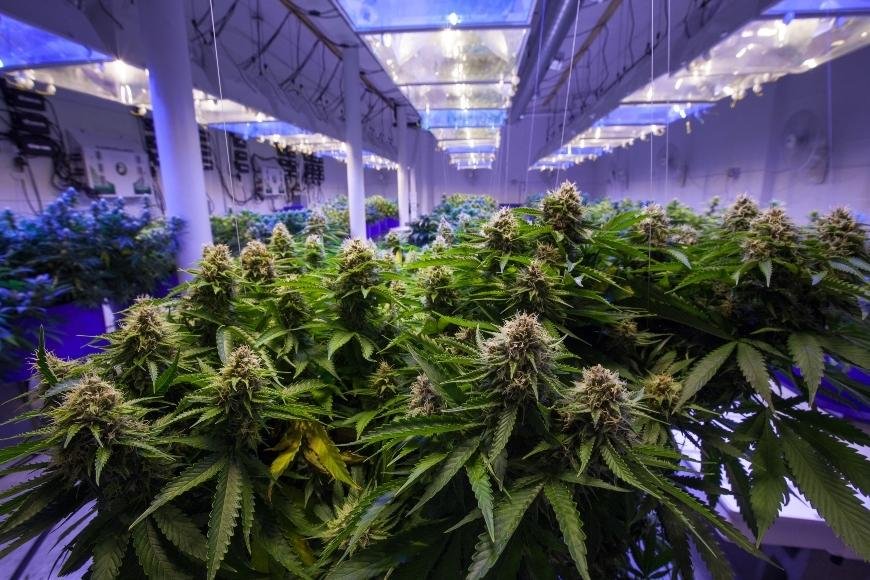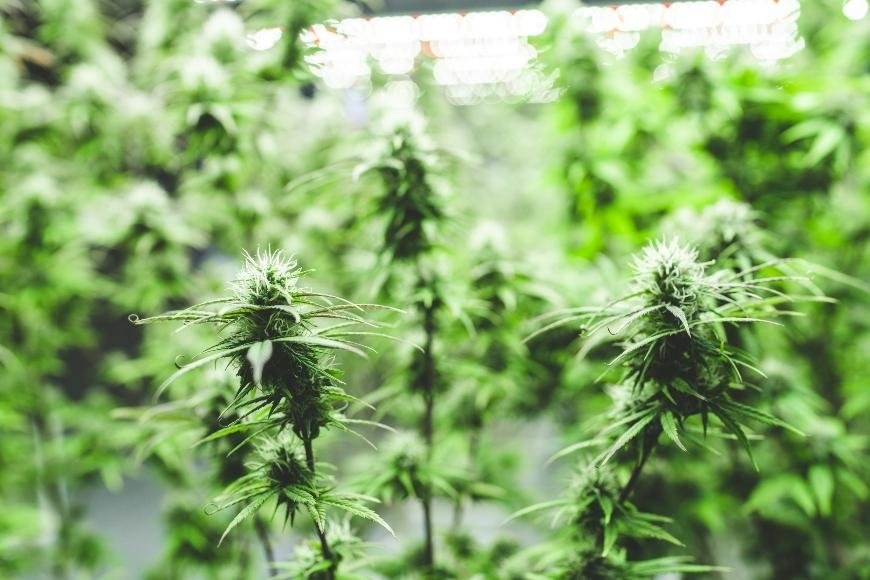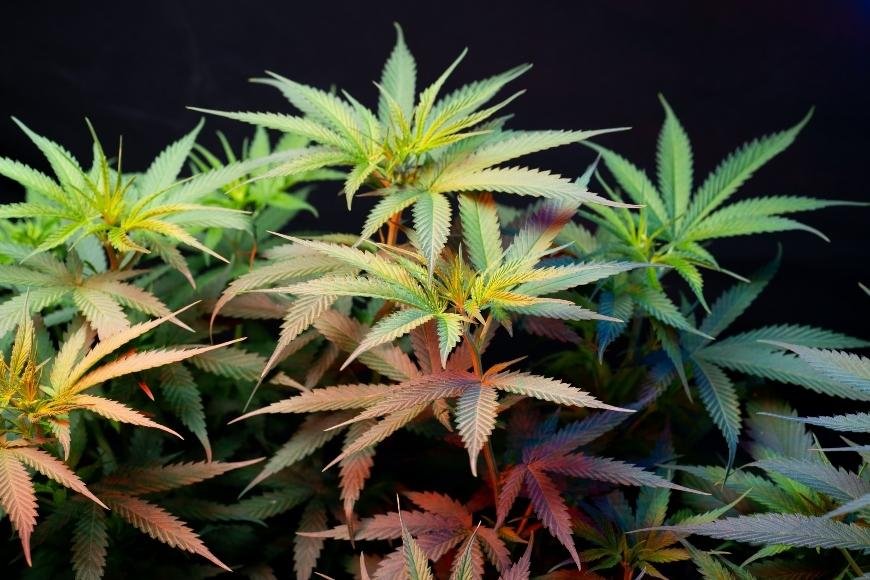How Many Cannabis Plants Can You Grow per Square Meter?
Discover how many cannabis plants you can grow per square meter and maximize your yields with our expert guide on lighting, air circulation, and more!

How many cannabis plants can you grow per square meter? This question is crucial for both novice and experienced growers looking to maximize their yields in limited spaces. In this blog post, we will delve into the various elements that can affect how many cannabis plants you can grow per square meter, including light requirements, air circulation, humidity and temperature control, plant training techniques and legal limits.
We'll discuss light requirements, air circulation, humidity and temperature control, as well as plant training techniques that help increase your overall yield. Additionally, we'll touch on legal plant limits and the benefits of growing cannabis at home. By understanding these elements and implementing them in your grow space, you'll be better equipped to determine how many cannabis plants can be grown per square meter while achieving optimal results.
Table of Contents:
- Maximizing Yields in Limited Spaces
- Create an Efficient Grow Space Layout
- Select Appropriate Strains
- Use Smart Pots or Air Pots
- Implement Plant Training Techniques
- Light Requirements
- Air Circulation
- Humidity and Temperature Control
- Plant Training Techniques
- Legal Plant Limits
- Benefits of Growing Cannabis at Home
- Frequently Asked Questions How Many Cannabis Plants Can You Grow Per Square Meter?
- Conclusion
Maximizing Yields in Limited Spaces
Cultivating cannabis at home can be an enjoyable and economical experience, but limited space often presents a challenge for growers. However, many growers face the challenge of limited space when cultivating their plants. In this section, we'll discuss some tips and techniques for getting the most out of a small grow space while ensuring healthy plant growth.
Create an Efficient Grow Space Layout
When working with limited space, it's essential to make every inch count. Start by measuring your available area and determining how many plants you can comfortably fit without overcrowding them. Consider using vertical gardening methods, such as trellises or hanging baskets, to maximize vertical space utilization.
Select Appropriate Strains
Choose cannabis strains that are known for their compact size and short stature. Indica-dominant strains typically have shorter flowering times and smaller overall sizes compared to Sativa-dominant ones. Autoflowering varieties are also ideal for small spaces due to their rapid growth cycle and reduced height.
Top Picks for Small Spaces:
- Northern Lights (Indica)
- Blueberry Autoflower (Indica)
- Girl Scout Cookies Extreme (Hybrid)
- Royal Dwarf (Autoflower)
Use Smart Pots or Air Pots
Smart pots and air pots are fabric containers that promote better root growth, leading to healthier plants with higher yields. They also help prevent overwatering and provide superior aeration compared to traditional plastic pots.
Implement Plant Training Techniques
Plant training techniques can significantly increase your cannabis yield in limited spaces by controlling the plant's shape and size. Some popular methods include:
- Topping: Removing the main growing tip of the plant encourages bushier growth with more bud sites.
- LST (Low-Stress Training): Gently bending branches away from the center of the plant allows for even light distribution and promotes horizontal growth.
- Mainlining: Creating a manifold structure by topping multiple times directs nutrients evenly throughout all branches, resulting in uniform colas.
- SOG (Sea of Green): Growing many small plants close together maximizes canopy coverage, allowing for efficient use of available light resources.
Maximizing yields in limited spaces requires careful consideration of the environment and resources available. Taking into account the restricted area, light needs must be thoughtfully assessed when cultivating cannabis plants.

Light Requirements
One of the most crucial factors in determining how many cannabis plants you can grow per square meter is the amount of light available. Optimal growth and higher yields can be achieved with the right amount of light, yet too much could lead to heat stress or overcrowding. However, it's essential to strike a balance between providing enough light for optimal growth without causing heat stress or overcrowding.
Wattage Matters
The wattage of your illumination devices is a major factor in ascertaining the number of plants that can fit into the space. Generally, when using HID lighting such as HPS or MH, you should target around 400-600 watts per square meter. If you're using LED (Light Emitting Diode) lights, which are more energy-efficient and produce less heat, aim for 200-300 watts per square meter.
Different Light Setups
- Single Grow Light: With just one low-wattage
- Moderate Wattage Setup: A setup with moderate wattages (250w - 400w), such as CFLs or smaller LEDs, may support up to four medium-sized cannabis plants per square meter.
- High-Wattage Setup: High-wattage setups (>600w), typically found in larger rooms with powerful HID or LED lighting systems, can potentially support up to sixteen small-to-medium sized cannabis plants per square meter if managed correctly.
Finding the Right Balance
Finding the right balance between plant density and available light is essential for healthy growth and high yields. Overcrowding your grow space can lead to poor air circulation, increased humidity, and a higher risk of pests or diseases. On the other hand, too few plants in a well-lit area may result in wasted energy and resources.
To find the right balance for your setup, consider factors such as plant size (determined by strain), desired yield per plant, and available light intensity. You can also experiment with different plant training techniques to maximize efficiency within your given space constraints.
Air Circulation
Proper air circulation is crucial for healthy cannabis plant growth, as it helps maintain an optimal environment and prevents issues like mold, pests, and diseases. In this section, we'll explore the importance of air circulation in your grow space and offer some advice on how to best achieve it.
Why Air Circulation Matters
Adequate airflow ensures that fresh carbon dioxide (CO2) reaches your plants while removing excess oxygen produced during photosynthesis. It also helps regulate temperature and humidity levels within the grow area by evenly distributing heat from lights or other sources. Additionally, good air movement can strengthen plant stems by simulating natural outdoor conditions.
Tips for Ensuring Proper Air Circulation
- Fans: Use oscillating fans to create a gentle breeze throughout your grow space. This will help prevent hotspots or stagnant areas where mold or pests could thrive. Make sure not to point fans directly at plants for extended periods; instead, aim them towards walls or ceilings so that they bounce back indirectly onto the foliage.
- Ventilation System: Install an exhaust fan with a carbon filter to remove stale air from the room while filtering out any odors associated with cannabis cultivation. Pairing this with an intake fan can further improve overall airflow efficiency.
- Negative Pressure: Ensure that there's slightly more exhaust than intake in your grow room setup - this creates negative pressure which aids in drawing fresh air into the space through passive vents or gaps around doors/windows.
- Maintain Plant Spacing: Avoid overcrowding your plants, as this can limit airflow and create a breeding ground for mold or pests. As mentioned earlier in the post, consider how many cannabis plants you can grow per square meter based on light availability and other factors.
By paying close attention to air circulation within your grow space, you'll be better equipped to maintain a healthy environment that promotes strong cannabis plant growth. This will ultimately contribute to higher yields and overall success in your home cultivation endeavors.
Humidity and Temperature Control
Maintaining the right humidity and temperature levels is crucial for optimal cannabis plant growth. Proper environmental conditions not only ensure healthy plants but also help prevent mold, pests, and other issues that can arise in an overcrowded grow space.
Optimal Humidity Levels
Cannabis plants thrive at different humidity levels throughout their life cycle. During the vegetative stage, an ideal relative humidity (RH) is between 40-70%, while during flowering it should be brought down to 40-50%. To monitor and maintain these levels within your grow space, consider investing in a hygrometer. If you need to increase humidity, try using a humidifier or placing trays of water near your plants. Conversely, if you need to decrease humidity levels within your grow area use a dehumidifier or increase air circulation with fans.
Temperature Control Tips
Ideal temps for cannabis growth are generally between 20°C and 30°C (68°F - 86°F), which helps to ensure vigorous vegetation as well as keeping heat-related issues or slowed development at bay. Maintaining this range helps promote vigorous growth while preventing heat stress or slowed development due to low temperatures. Here are some tips on how to regulate temperature:
- Invest in proper equipment: A reliable thermometer will allow you to accurately monitor temperature fluctuations within your grow space.
- Air conditioning & heating units: Depending on where you live and what time of year it is; having access to both an air conditioner and heater may be necessary for maintaining optimal growing conditions.
- Proper insulation: Insulating your grow space can help maintain stable temperatures and reduce energy costs. Make sure to seal any gaps or cracks that may allow drafts.
- Fans & ventilation: Installing fans and proper ventilation systems will not only help regulate temperature but also improve air circulation, preventing mold and pests from taking hold in your garden.
The amount of cannabis plants you can cultivate per square meter is contingent upon various conditions, such as light access, plant size, and environmental elements. By maintaining optimal humidity levels and temperature control within your grow space, you'll be one step closer to a successful harvest.
Plant Training Techniques
Growing cannabis in limited spaces requires some creativity and skill to maximize yields. By using plant training techniques like topping, pruning, and low-stress training (LST), you can make the most of your available space while ensuring healthy growth for your plants.
Topping
Topping is a technique that involves cutting off the main stem's tip, which encourages the plant to grow multiple branches instead of just one central cola. This results in more bud sites and an even canopy, allowing all parts of the plant to receive equal light exposure. Topped plants tend to be bushier with higher yields compared to untrained ones.
Pruning
Pruning is another effective method for maximizing yield in small spaces by removing unnecessary leaves or branches from your cannabis plants. This helps direct energy towards developing buds rather than maintaining excess foliage. Focus on eliminating lower branches that don't receive much light as well as any dead or dying leaves that could lead to mold or pest issues.
Lollipop Pruning Technique:
- Cut away lower branches leaving only top colas - this resembles a lollipop shape.
- Promotes airflow around base reducing chances of mold & pests.
- Frees up energy for upper buds resulting in larger harvests.
Low-Stress Training (LST)
Low-Stress Training (LST) is a gentle technique that involves bending and tying down branches to create an even canopy. This allows all parts of the plant to receive equal light exposure, resulting in more bud sites and potentially higher yields. LST is particularly useful for growing cannabis plants in small spaces or under low-wattage lights.
Steps for Low-Stress Training:
- Gently bend branches away from the main stem using soft ties or string.
- Secure tied branches to the edge of your grow container or pot.
- Adjust ties as needed throughout growth stages, ensuring no damage occurs.
Incorporating these plant training techniques into your cannabis cultivation routine can help you make the most out of limited space while optimizing yield potential. Remember always to monitor your plants closely and adjust their environment as necessary for healthy growth and maximum productivity.

Legal Plant Limits
Before diving into the world of cannabis cultivation, it's crucial to understand and abide by your local laws and regulations. Growing more plants than allowed can lead to severe consequences, including fines or even imprisonment. Research the specific regulations of your locality to ensure you remain within legal plant limits.
Federal vs. State Laws
In the United States, federal law still prohibits cannabis; however, individual states have enacted laws to regulate its use and cultivation for medical or recreational purposes.
Countries with Decriminalized Cannabis Cultivation
In other parts of the world where cannabis has been decriminalized or legalized entirely - such as Canada or Uruguay - there are also strict guidelines on home cultivation that must be followed.
Legal Plant Limits are an important factor to consider when growing cannabis at home. Growing your own plants can offer a variety of benefits, so it is essential to understand the legal limits before starting this endeavor.
Benefits of Growing Cannabis at Home
Young adults have been turning to home-growing cannabis more and more, with valid cause. Cultivating your own plants offers numerous advantages over purchasing from a dispensary or other sources. In this section, we'll explore some of the top benefits that come with growing cannabis in your own space.
Cost Savings
By cultivating cannabis at home, you can enjoy cost savings that may not be achievable through dispensaries or dealers. While there may be an initial investment in equipment and seeds, over time you can save money by producing your own supply.
Better Quality Control
When you grow your own cannabis plants, you have complete control over their environment and nutrients. This means you can ensure they receive proper care throughout their growth cycle, resulting in higher quality buds than what might be available commercially. Plus, knowing exactly how your plants were grown gives peace of mind regarding pesticide use and overall plant health.
Variety Selection
- Sativa: Known for its uplifting effects; ideal for daytime use or socializing.
- Indica: Provides relaxation and body-focused effects; perfect for evening use or unwinding after a long day.
- Ruderalis: A less common variety used primarily for breeding autoflowering strains due to its ability to flower regardless of light exposure changes.
By cultivating various strains yourself, it's possible to tailor each harvest according to personal preferences.
Hobby Satisfaction & Personal Connection
Growing cannabis at home can be a rewarding hobby that allows you to develop a personal connection with your plants. As you nurture them from seedlings to harvest, it's easy to take pride in the fruits of your labor and appreciate the process behind producing quality buds.
Environmentally Friendly
Homegrown cannabis has a smaller carbon footprint compared to commercially produced products. By growing locally, transportation emissions are reduced, and waste is minimized since packaging materials aren't needed for individual sales transactions. Additionally, many growers choose organic methods or permaculture techniques, which further reduce environmental impact.
Frequently Asked Questions How Many Cannabis Plants Can You Grow Per Square Meter?
How many cannabis plants grow per square foot?
The number of cannabis plants that can be grown per square foot depends on the growing technique and plant size. Generally, one large plant or four smaller plants can be grown in a 1-square-foot area using the Sea of Green (SOG) method.
How many cannabis plants can you grow in 100 square feet?
In a 100-square-foot space, you could potentially grow up to 400 small cannabis plants using the Sea of Green method or around 25 larger plants with proper spacing and training techniques like Screen of Green (SCROG).
How many cannabis plants can you grow in 5 acres?
A five-acre plot could accommodate approximately 8,000-10,000 outdoor-grown marijuana plants with adequate spacing for sunlight exposure and growth. However, this estimate may vary depending on local regulations and cultivation methods used.
How many cannabis plants can I fit in a 4x8?
In a standard-sized indoor tent measuring at least four by eight feet (32 sq ft), it is possible to fit between eight large marijuana crops or as much as thirty-two smaller ones utilizing efficient training techniques such as Low-Stress Training (LST) or High-Stress Training (HST).
Conclusion
The amount of cannabis plants to be cultivated per square meter will vary based on the grower's light source, space and plant size, as well as environmental factors such as air circulation, humidity and temperature. Growers must consider their available light, grow space and plant size when deciding how many plants to cultivate. Proper air circulation, humidity and temperature control are essential for healthy growth as well as utilizing training techniques like topping or pruning if needed. Additionally, growers should always adhere to legal limits in their region when determining how many cannabis plants they can grow per square meter. With careful planning and consideration of all these elements, growers will have no problem cultivating an abundant harvest.
























































































































